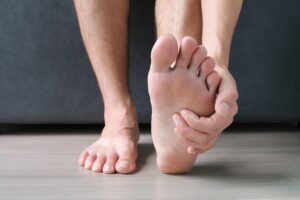Flat Feet Treatment in Northern New Jersey
 Flatfoot is a medical condition that means a patient has flat or fallen arches in one or both feet, occasionally causing pain and discomfort. Patients with flat feet and other podiatry conditions can find comprehensive care at Bergen Medical Associates, a multi-specialty provider serving northern New Jersey. Learn more about the condition and flat feet treatment from Bergen Medical Associates.
Flatfoot is a medical condition that means a patient has flat or fallen arches in one or both feet, occasionally causing pain and discomfort. Patients with flat feet and other podiatry conditions can find comprehensive care at Bergen Medical Associates, a multi-specialty provider serving northern New Jersey. Learn more about the condition and flat feet treatment from Bergen Medical Associates.
What Is Flatfoot?
Feet normally have arches to support weight distribution, proper posture, and a natural gait. When feet have low or no arches when standing, the condition is known as flat feet (pes planus), sometimes called flatfoot. This is a common condition that is often painless but can lead to pain and discomfort with physical activity. Flat feet can develop in childhood or later in life, often from an underlying condition. There are two main types of flat feet:
Flexible Flat Feet
Flexible flat feet are the most common type and occur when an arch is visible when the patient sits or stands on tiptoes, but not when walking. This type is often found in children, but it is usually painless and goes away when feet fully develop.
Rigid Flat Feet
Rigid flat feet occur when a patient does not have an arch regardless of walking, sitting, or standing. This type is less common, usually happening in patients with joint or bone disorders.
Flat feet can occur in one or both feet depending on the cause and severity.
What Are the Signs and Symptoms of Flat Feet?
Most people with flat feet do not experience symptoms, but patients with more severe cases can experience pain or discomfort. Symptoms of flat feet include:
- Pain or aches in the feet, which may worsen with activity
- Pain in the knees, ankles, or hips
- Swelling, often around the ankles
- Stiffness
- Uneven gait
- Unsteady balance
- Changes in the appearance of toes
- Changes in toe flexibility
If patients do not experience any symptoms or discomfort from flat feet, then treatment is not necessary. Patients who have pain should speak to their doctor or podiatrist about treatment options.
What Are the Causes and Risk Factors of Flat Feet?
Flat feet are related to the development of the tissues and bones in the feet and lower legs, occurring when tendons are too loose. Therefore, many babies and children have flat feet before arches and tendons fully develop. This often resolves when tendons tighten in early childhood, but some children (and adults) may never develop arches. Sometimes flat feet can be due to an underlying condition or injury, which often requires treatment. Conditions that can increase a person’s risk of flat feet include:
- Cerebral palsy
- Muscular dystrophy
- Ehlers-Danlos syndrome
- Marfan syndrome
- Plantar fasciitis
- Rheumatoid arthritis
- Posterior tibial tendon dysfunction
Other common risk factors for developing flat feet as an adult include obesity, pregnancy, diabetes, genetics, aging, and injury to the foot or ankle. Depending on the cause, patients can have flat feet in one or both feet.
How Are Flat Feet Diagnosed?
As mentioned above, most people with flat feet will not experience pain or other symptoms and do not need to consult a doctor for treatment. However, patients who experience persistent symptoms, especially after physical activity, should see their doctor or podiatrist to either confirm a flat feet diagnosis or rule out other possibilities.
Typically, the healthcare provider will examine the patient’s feet to see if there is an arch present when sitting, standing, or walking. If no arch is seen and the patient has pain, imaging tests like X-rays or CT scans may be ordered to better see the tendons and bones in the feet.
What Are the Flat Feet Treatment Options?
If flat feet are causing persistent pain and discomfort, the medical team will work with the patient to decide on the best treatment option. There are a variety of treatments for flat feet, ranging from mild and non-invasive to invasive for more severe cases. These treatments include:
Foot Supports and Orthotics
One of the first treatment options to help treat pain related to flat feet is using orthotics, which are supportive inserts put in shoes. Orthotics can be custom-designed for flat feet to help relieve pain, pressure, and discomfort. Wearing supportive shoes that are extra wide or ankle braces can also help add support and reduce inflammation.
If children have flat feet from a medical condition, they may need special shoes, heel cups, or orthotics. Patients should use orthotics under the supervision of their doctor to prevent the accidental worsening of symptoms.
Medication
Another treatment option for flat feet is using medications like painkillers to relieve discomfort and swelling. If the cause of flat feet is an underlying condition, the patient may be prescribed medications to reduce the initial symptoms.
Lifestyle Changes
Depending on the cause of a patient’s flat feet, lifestyle changes may be recommended. In patients where obesity is a factor, a doctor may recommend weight loss and gentle exercise to reduce the stress on the arches. Although exercise is ideal for losing weight, patients whose pain gets worse with activity should not stand or walk for long periods. Gentle stretches of the feet and calves can also help improve strength and flexibility, helping to reduce pain.
Surgery
In more severe cases of flat feet, surgery may be a suitable treatment option, although it is typically the last resort. Surgery can be done for a variety of reasons, including:
- Creating or restoring an arch in the foot
- Repairing tendons in the feet
- Fusing bones or joints to a correct position
- Treatment options for flat feet are varied and each case is unique.
- Treatment options for flat feet are varied and each case is unique.
Treatment options for flat feet are varied and each case is unique. Bergen Medical Associates’ podiatry department is led by Samantha Rosenzweig, DPM, who believes that most foot problems can be treated non-surgically. However, she does specialize in the surgical management of forefoot deformities especially arthritis of the big toe. Dr. Rosenzweig works to personalize each patient’s treatment plan for the best results.
Why Seek Treatment at Bergen Medical Associates?
Patients in the northern New Jersey area with flat feet or other podiatry conditions can trust Bergen Medical Associates for their care. With a team of more than 40 board-certified physicians, nurses, and practitioners, Bergen Medical Associates provides comprehensive medical care in a wide range of specialties.
We handle each patient with a whole-person approach, ensuring that everyone gets individualized care. With extended hours, same-day appointments, and locations throughout northern New Jersey, Bergen Medical Associates is the place to go for many medical needs, including flat feet treatment.
Request a Podiatry Appointment Today
Patients with a flatfoot diagnosis or those who suspect one should consider contacting the podiatry specialists at Bergen Medical Associates. With a long-standing reputation for providing comprehensive medical care throughout northern New Jersey, Bergen Medical Associates can be counted on for the diagnosis and treatment of medical conditions. Contact us to learn more about flat feet treatment or to request an appointment.










